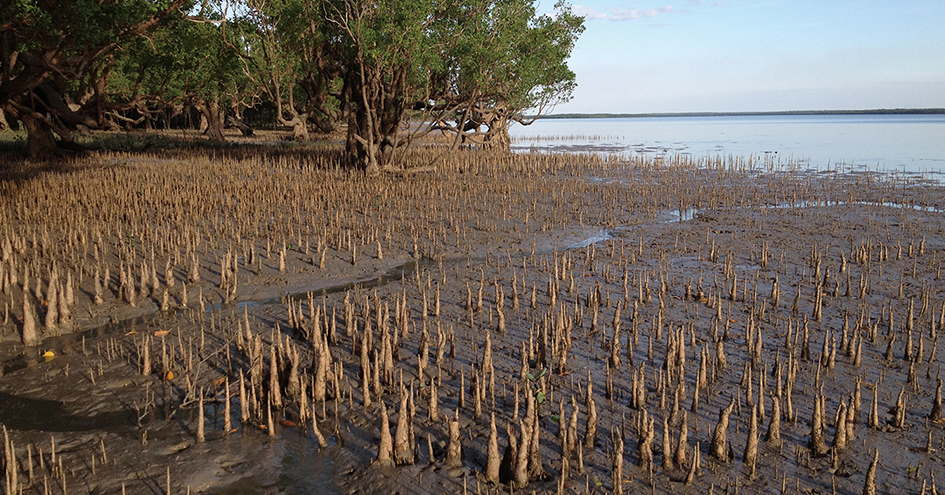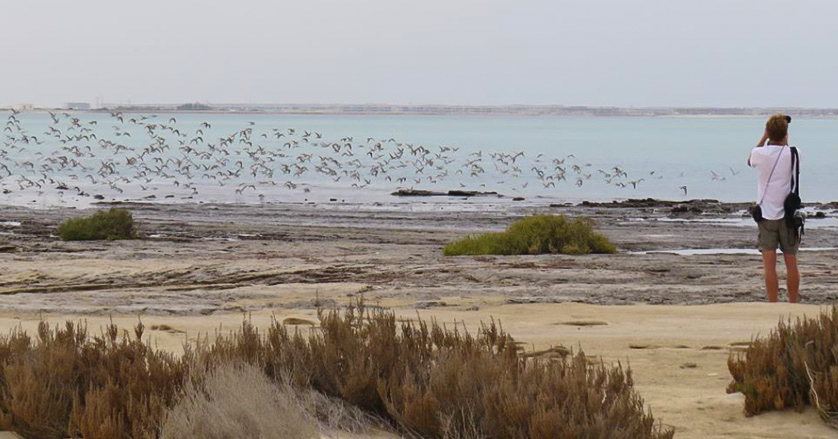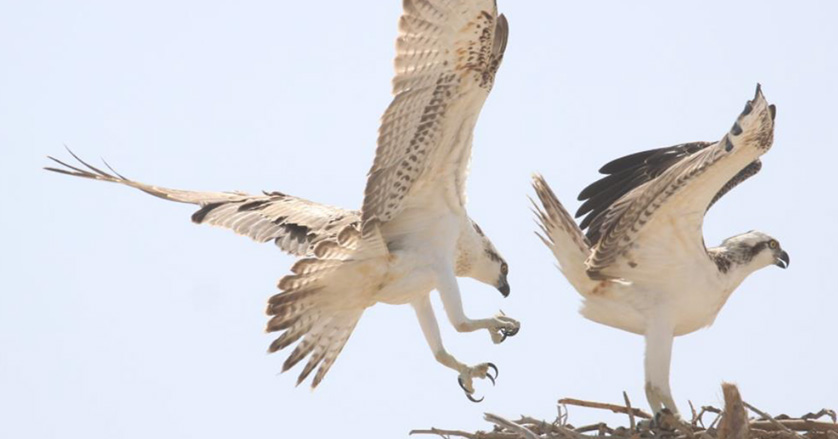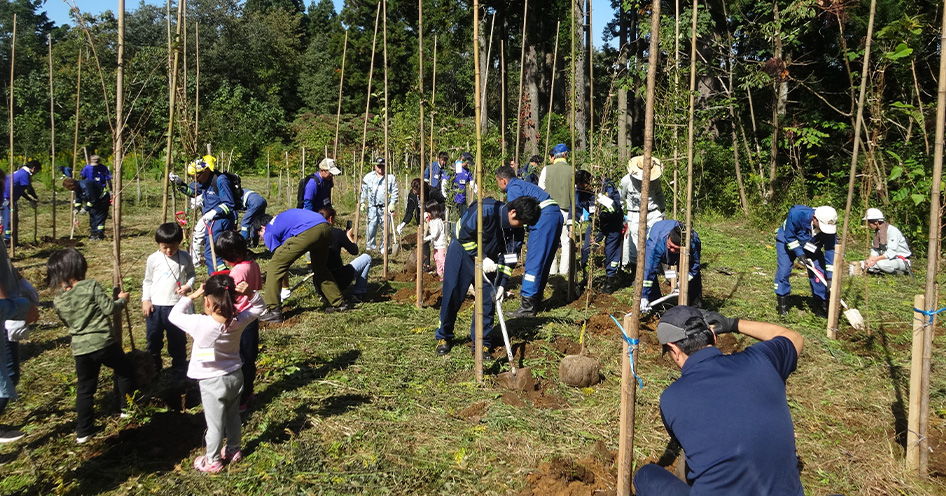Biodiversity Conservation
Recognizing biodiversity conservation as another significant global environmental issue, we have positioned it as one of our Key Tasks. We established and published our Policy and Commitments on Biodiversity Conservation in December 2022, following resolution by the Board of Directors.
Policy and Commitments on Biodiversity Conservation
Our Policy
We identify biodiversity related risks and opportunities in our businesses and actively promote initiatives for the conservation and sustainable use of biodiversity based on the mitigation hierarchy1.
Commitments
- Identify biodiversity related risks and opportunities
- We will identify risks and opportunities for biodiversity in our business and promote initiatives for sustainable use.
- We will promote disclosure of information on biodiversity conservation activities.
- Set Exclusion Zones for our businesses
- We will not operate our businesses inside UNESCO World Natural Heritage site boundaries.
- Develop Net Positive Approaches
- For our businesses located in critical habitats2, we will develop and implement Biodiversity Action Plans (BAP), including creating net positive impact.
- Enhance Biodiversity Conservation Activities
- For new businesses, we will identify impacts on biodiversity and develop and implement measures to avoid or reduce impacts based on the mitigation hierarchy.
- For existing businesses, we will reduce negative impacts on biodiversity to the extent possible and promote initiatives to create positive impacts on biodiversity.
More on Policy and Commitments on Biodiversity Conservation (inpex.co.jp)
1 Order of priority to avoid, reduce or minimize development impacts and then taking compensatory measures for remaining impacts.
2 Areas of high biodiversity value as defined in IFC Performance Standard 6.
The type and degree of impact that our operations have on biodiversity differ depending on the scale, activities, or location of each project. Accordingly, the biodiversity conservation efforts required for each project also differ. Therefore, we assess the importance of biodiversity in the areas in which we operate, and the risks and impacts on biodiversity that each project brings. We then apply a mitigation hierarchy3 to plan strategies for avoiding, mitigating, and compensating for those risks and impacts, and to conserve biodiversity, in environmentally sensitive areas that are particularly important (protected areas, critical habitats of threatened species, forests, mangroves, coral reefs, wetlands, and tidal flats, etc.).
3 Mitigation hierarchy: Defined as i) Avoidance, ii) Minimization, iii) Rehabilitation/Restoration, and iv) Offset
Identification of Risks and Opportunities Related to Biodiversity
In line with the LEAP approach of the TNFD framework4 beta release, we are assembling nature-related information—such as on ecosystem points of contact, endangered species, and water stress—for the areas around our domestic operations. Going forward, we will use the results of these efforts to assess the relationships between our business operations and nature in terms of impact and dependence. We will also consider nature-related risks and opportunities for the Group.
4 TNFD framework: A framework established by the Taskforce on Nature-related Financial Disclosures (TNFD) to assess nature-related risks and opportunities, and to disclose that information. The LEAP approach is one process proposed in the framework for systematically assessing nature-related risk and opportunities. The LEAP approach involves four phases: (1) Locate your interface with nature; (2) Evaluate your dependencies and impacts; (3) Assess your risks and opportunities; and (4) Prepare to respond to nature-related risks and opportunities, and report to investors.
Avoidance and Mitigation of, and Compensation for, Impacts to Protected Areas
Since FY2019, we have been enhancing our geographical information system (GIS) with information on protected areas obtained from the World Database on Protected Areas (WDPA),5 and animal and plant species that fall under the International Union for Conservation of Nature (IUCN) Red List categories. Information is updated annually for the following purposes:
- Confirmation if our operator projects operate in any protected area
- Initial screening of potential impacts of new projects to protected areas
- Planning for biodiversity conservation activities in existing projects
We have also made a commitment in our Policy and Commitments on Biodiversity Conservation to “not operate our businesses inside UNESCO World Natural Heritage site boundaries”.
We have confirmed that, as of December 31, 2022, none of our operator projects are operating in areas that we have defined as exclusion zones.
5 World Database on Protected Areas (WDPA): Developed jointly by the United Nations Environment Programme (UNEP)—a major agency established in 1972 within the United Nations in the environmental field—and the International Union for Conservation of Nature (IUCN)—an international nature conservation network comprising nations, government agencies, and non-government organizations that was established in 1948 under global cooperation
Promotion of a Net Positive Approach
To better understand the present situation of our nature-related efforts and identify further actions, we have looked to the World Business Council for Sustainable Development (WBCSD) practitioner’s guide: “What does nature-positive mean for business?”. Using the guide, we have identified areas in which we are making particular progress, such as developing and issuing our commitments on biodiversity and water, and applying a mitigation hierarchy to avoid, mitigate, and compensate for our impacts on biodiversity.
In the future, we will consider nature-related impacts and dependences in terms of the value chain and implement initiatives that contribute to net positive impacts.
Promotion of Biodiversity Conservation Activities
For many years, we have been conducting activities that contribute to biodiversity conservation at our domestic and overseas sites. We will continue to enhance our biodiversity conservation activities across the Group based on our Policy and Commitments on Biodiversity Conservation.
Overseas Activities to Conserve Biodiversity
The Ichthys LNG onshore processing plant is located in Darwin Harbour, where extensive mangrove forests along the coast provide breeding and feeding grounds for fish and sea turtles. To protect this rich biodiversity, Ichthys LNG has continued to comprehensively monitor effluent quality, seawater quality, and growing conditions for mangrove forests, and other natural vegetation. We further contribute to biodiversity conservation around the plant by providing grants to marine research projects such as long-term dolphin and dugong studies in the Northern Territory.
More on this in the Cardno report: “Darwin Harbour – A Summary of the Ichthys LNG Project Nearshore Environmental Monitoring Program” (see page 98)

Wild Bird Surveys at the Onshore Block 4 Project
We have been exploring Onshore Block 4 in the UAE since being awarded exploration rights in FY2019. The block is in a central coastal area of the country that encompasses Abu Dhabi.
Balghelam and Umm Al Barak, two islands roughly 20 kilometers northeast of Abu Dhabi that are drilling sites for this project, are noted as resting and roosting places for migratory birds. Several times a year, JODCO Exploration Limited commissions a survey of birds inhabiting the islands to examine their situation and develop strategies for mitigating potential project impacts on these birds.


Activities to Conserve Biodiversity in Japan
Understanding the Characteristics of Environments around Domestic Offices
In FY2021, we conducted desktop reviews to understand the characteristics of environments around domestic offices (rivers, fishing grounds/farms, forests, biodiversity conservation areas, cultural properties, and critical habitats of threatened species). We then compiled this information in the form of a GIS. This not only enabled us to understand the ecosystems around our domestic offices, but to also understand environmentally sensitive areas around new projects sites at the planning stage.
“Kitsunedaira Donguri-no-mori” Ecosystem Survey
As part of an ongoing forestation support program launched by Niigata Prefecture in FY2010, the Kitsunedaira Donguri-no-mori (Acorn Forest) project is being conducted in Nagaoka City’s Fudosawa district, adjacent to the Nagaoka Field Office. We are implementing the following initiatives through this project.
Planting Trees and Caring for the Forest
Twice a year, in spring and autumn, our employees work with local residents on forest maintenance, tree planting activities, and holding nature observation meetings for children. (This initiative has been suspended since 2020 due to COVID-19.)

Planting trees as part of the Donguri-no-Mori project
FY 2019 Biodiversity Survey (autumn)
In autumn of FY2019 (October–November), we conducted a simple survey to examine the state of Donguri-no-mori’s biodiversity. For the survey, we set up six sensor cameras to capture images of creatures living in the forest.
We observed several species of mammals at the site, including Japanese serow, and several species of birds in and around the area.

FY2022 Biodiversity Survey
Building on our observations from the FY2019 survey, we conducted another survey in FY2022 to more fully understand the current state of biodiversity in Donguri-no-mori. Conducted over roughly an eight-month period between May and December 2022, we placed eight sensor cameras in the forest to capture images of creatures living there. A literature review was conducted alongside the field survey.
FY2022 Biodiversity Survey: Results
The survey confirmed the presence of gray-faced buzzards (birds) and foxes (mammals) at the apex of the Donguri-no-mori ecosystem. It also found that a wide variety of creatures use the forest throughout the year. It is not possible to obtain such a result over a short timeframe from a single reclaimed environment comprising only forests and grasslands. We understand this to be an overall improvement of species and ecosystem diversity as the result of 13 years of continuous care of the environment through ongoing forestation efforts (since FY2010).




